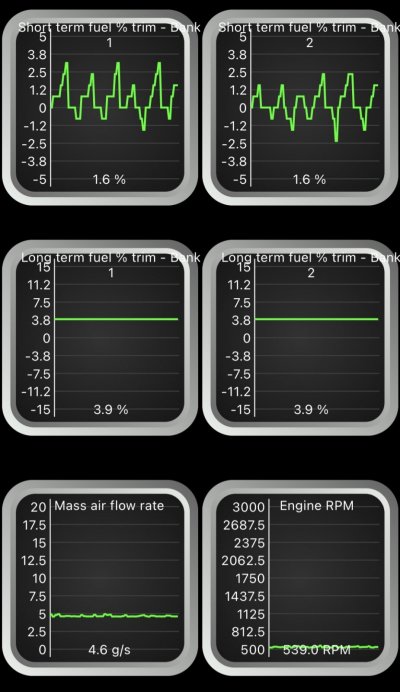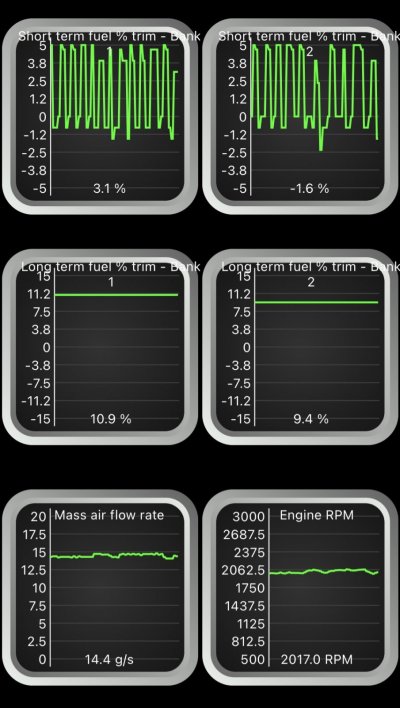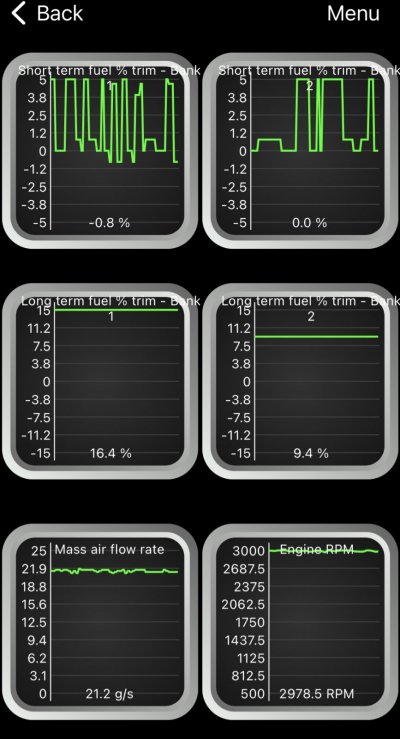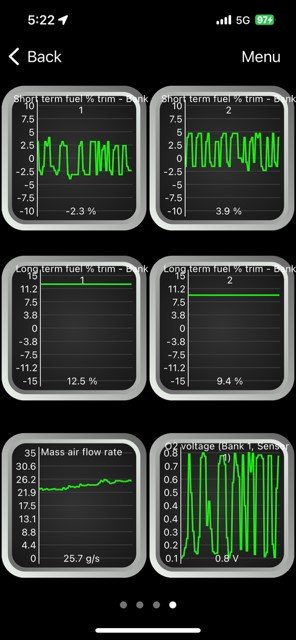You are using an out of date browser. It may not display this or other websites correctly.
You should upgrade or use an alternative browser.
You should upgrade or use an alternative browser.
My current fuel trims - idle, 2000rpm, 3000rpm all no load
- Thread starter 2006Tahoe2WD
- Start date
Disclaimer: Links on this page pointing to Amazon, eBay and other sites may include affiliate code. If you click them and make a purchase, we may earn a small commission.
Scottydoggs
Full Access Member
+/- 5 is perfect.
LTFTs are learned over time over various RPMs and engine loads. Your STFTs look fine, but compare them under load (maybe carefully power braking). Adding LT & ST trims (by banks) together, they should be within ±10% so they are a bit high now.
If you've had any trouble in the recent past that's been corrected (vacuum leak, MAF cleaned or replaced, O2 sensors changed, spark plugs, air filter, etc.) then I'd suggest resetting the LTFTs with a scanner, and monitoring them going forward. Even if no problems like that have been fixed, it might be a good idea to reset them anyway, and monitor to see if they come back high over time. (The STFTs will be reset at each ignition cycle.)
It wouldn't hurt to see if the computer sees more alcohol than you're actually running; what do you run: ethanol-free, E10, E15, or some version of E85? If not high alcohol-content fuel, but the computer thinks there is more alcohol than there actually is, then it will be adding fuel. But that situation usually shows up in the STFTs. If you've run E85 or a high alcohol content fuel in the recent past, reset those LTFTs and monitor.
I'm curious as to how much they change over time.
If you've had any trouble in the recent past that's been corrected (vacuum leak, MAF cleaned or replaced, O2 sensors changed, spark plugs, air filter, etc.) then I'd suggest resetting the LTFTs with a scanner, and monitoring them going forward. Even if no problems like that have been fixed, it might be a good idea to reset them anyway, and monitor to see if they come back high over time. (The STFTs will be reset at each ignition cycle.)
It wouldn't hurt to see if the computer sees more alcohol than you're actually running; what do you run: ethanol-free, E10, E15, or some version of E85? If not high alcohol-content fuel, but the computer thinks there is more alcohol than there actually is, then it will be adding fuel. But that situation usually shows up in the STFTs. If you've run E85 or a high alcohol content fuel in the recent past, reset those LTFTs and monitor.
I'm curious as to how much they change over time.
Last edited:
2006Tahoe2WD
Full Access Member
Recent: cleaned MAF, 4 new OEM O2 sensors, new purge valve.LTFTs are learned over time over various RPMs and engine loads. Your STFTs look fine, but compare them under load (maybe carefully power braking). Adding LT & ST trims (by banks) together, they should be within ±10% so they are a bit high now.
If you've had any trouble in the recent past that's been corrected (vacuum leak, MAF cleaned or replaced, O2 sensors changed, spark plugs, air filter, etc.) then I'd suggest resetting the LTFTs with a scanner, and monitoring them going forward. Even if no problems like that have been fixed, it might be a good idea to reset them anyway, and monitor to see if they come back high over time. (The STFTs will be reset at each ignition cycle.)
It wouldn't hurt to see if the computer sees more alcohol than you're actually running; what do you run: ethanol-free, E10, E15, or some version of E85? If not high alcohol-content fuel, but the computer thinks there is more alcohol than there actually is, then it will be adding fuel. But that situation usually shows up in the STFTs. If you've run E85 or a high alcohol content fuel in the recent past, reset those LTFTs and monitor.
I'm curious as to how much they change over time.
The motor is not flex fuel. I think the fuel I buy is 10% alcohol.
My Foxwell scanner has an issue (corrupted memory) and is a brick at this point. The "fix" /reset process isn't working for me. When it was working the new O2 sensors were working great.
I read that if the battery is disconnected for ? 1 hour it will reset the LTFTs. Any truth in that?
Thanks much.
2006Tahoe2WD
Full Access Member
One idea is to rig up a propane "fogging" system and see if I find a leak.
Scottydoggs
Full Access Member
pulling the battery for 30 minutes resets the whole pcm. so all systems would need to re learn and pass the internal test to become "ready".
a large vac leak would have set a lean code by now and your trims would be +25.
a large vac leak would have set a lean code by now and your trims would be +25.
a large vac leak would have set a lean code by now and your trims would be +25.
Agreed. The STFTs are way too good at idle to have a larger sized vacuum leak.
Mudsport96
Full Access Member
Is this driving/ under load? Or are you in park just revving? All data points need to be taken in a real world scenario, i.e. driving. Long terms are a bit high, but the computer is always trying to get to its programmed fuel mix. So if it was "seeing" lean exhaust, it would add more fuel. So if the O2 sensors were shot, and it was overfueling because it thought it was lean the trims will be high.
2006Tahoe2WD
Full Access Member
Agreed. The STFTs are way too good at idle to have a larger sized vacuum leak.
Somewhat agree. Whatever vacuum leak (small) and/or fuel not getting fulling delivered this has been now compensated by the LTFTs leading to the STFTs to be rather close to zero.
Agree, if I had a "big" vacuum leak there would be a code by now and or the STFTs would be high (~20%) trying to get to the proper a/f target.
Mudsport - If you want me to post STFTs and LTFTs while driving on the highway - I can do that. The last time I did that the LTFTs were highish - ~10% and the STFTs were lowish <5%.
Some of you out there have a scanner. How about posting what you actually read for LTFTs and STFTs at idle and e.g. 2000 rpm to start with.
Also, I disconnected the battery for one hour and it didn't seem to reset the LTFTs.
2006Tahoe2WD
Full Access Member
Similar threads
- Replies
- 5
- Views
- 226
- Replies
- 25
- Views
- 7K
- Replies
- 2
- Views
- 2K




